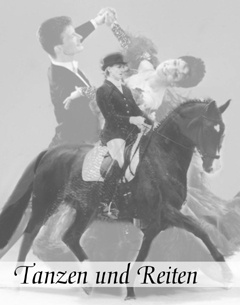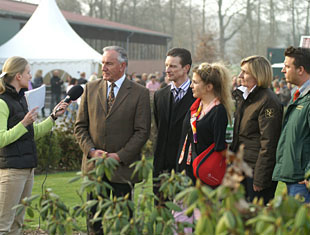
What a perceptive and illuminating seminar! The title and main topic of the three-hour event, the parallels between riding and dancing, offered new perspectives to dressage riders within an engaging framework of entertainment, insights and beautiful horses.
Susanne Miesner, the brain behind the ‘Classical Sales Warendorf’ concept, inaugurated the seminar with a talk touching upon several crucial points of the training of both horse and rider and of the correct management of the dressage horse. She stressed the importance of a global, comprehensive approach to riding, which ranges from the physical fitness of the rider (leading to correct muscle use) to the importance of daily turnout for the horses.
Miesner was soon joined on the stage by Michael Hull, a ten-time World Champion in several dancing disciplines with three different partners. It was easy to highlight the similarities between riding and dancing, from the attraction between two beings which triggers the partnership, to the value of trust within that partnership. It was clear that most of the key points of dancing, such as the concepts of tension, relaxation, beat, and correct posture, can also be applied to riding, in an almost identical way.
Indeed, one of the most illuminating passages of the talk was the analysis of the elements of the Training Scale from a riding and a dancing perspective: Susanne Miesner explained each of the six criteria of the Skala der Ausbildung, and Michael Hull commented, with much wit and humour, on how these can be applied to dancing. So, for instance, a concept such as relaxation (Losgelassenheit), implies in both disciplines a mental and physical relaxation, which, however, must be interpreted correctly: relaxation can never be produced through force. Michael Hull mentioned tango as the perfect exemplification of the combination of positive tension and mental and physical relaxation.
 Klaus Balkenhol then contributed to the event with an insightful talk. Commenting on the over-use of the word ‘classical’, he proposed to substitute the term with the phrase ‘training that respects the horse’, referring to a training methodology which is applied in harmony, quietly, and in an exemplary way. Indeed, he pointed out an often-forgotten, but wholly logical, fact: the 1912 Richtlinien, the German guidelines, were originally written for police horses, and, therefore, the initial aim of the Skala precisely focused on long-term soundness – because a police horse could not be replaced after two or three years, having been rendered unsound by incorrect training. The necessity of re-stating both the validity of these principles and their relevance for present-day riders has led to the creation of the ‘Xenophon’ society; and indeed, these principles, dating from Xenophon’s age – as early as 400 B.C. – are still valid today and, even more significantly, can be applied across the whole spectrum of equestrian disciplines.
Klaus Balkenhol then contributed to the event with an insightful talk. Commenting on the over-use of the word ‘classical’, he proposed to substitute the term with the phrase ‘training that respects the horse’, referring to a training methodology which is applied in harmony, quietly, and in an exemplary way. Indeed, he pointed out an often-forgotten, but wholly logical, fact: the 1912 Richtlinien, the German guidelines, were originally written for police horses, and, therefore, the initial aim of the Skala precisely focused on long-term soundness – because a police horse could not be replaced after two or three years, having been rendered unsound by incorrect training. The necessity of re-stating both the validity of these principles and their relevance for present-day riders has led to the creation of the ‘Xenophon’ society; and indeed, these principles, dating from Xenophon’s age – as early as 400 B.C. – are still valid today and, even more significantly, can be applied across the whole spectrum of equestrian disciplines.
Paul Stecken’s maxim, ‘correct riding is enough’, was repeated throughout the afternoon by different speakers –therefore almost acting as the fil rouge of the event– and was applied, in practice, by the riders, who without putting undue pressure on their mounts still allowed the audience to see the true quality of the horses in a quiet, unimposing fashion.
The three-year-olds showed remarkable mental and physical relaxation in front of the audience of over 250 people; and correct riding –often done in a remonte seat, and with constant guidance from the ground from Susanne Miesner– without pushing continuously for showy trots or extravagant extensions, surely enabled them to have a thoroughly positive first public appearance, while still allowing them to show true quality in their basic gaits. The fact that one of the riders was a 14-year-old girl contributed to show how trustful and how truly relaxed these youngsters were.
Correct training without pressure does not prevent above-average quality from shining through. In fact, it enhances it: the audience had goosebumps when Die Callas, a gorgeous, lofty-moving 4-year-old mare, took the scene on her own accompanied solely by music and leaving spectators in awe. Balkenhol commented on the correctness and expressiveness of all three gaits and of her walk in particular. Highlighting especially how smoothly the mare was working over her back, he reminded the audience that the importance of the back cannot be overestimated, and that it is fundamental not to be fooled by horses with spectacularly-moving front legs but lacking engagement from behind.
The presentation of some of the auction horses continued with a group of 4- and 5-year-olds, and finally concluded with a selection of more advanced horses, including a 7-year-old schooling S-level movements, a 6-year-old working at M level, and a lovely pony stallion. What emerged from this final group was, again, remarkable mental and physical relaxation and trust in the rider, coupled with a higher degree of balance, visible especially in the canter work, as the natural consequence of years of correct training.
Finally, Michael Hull performed a practical demonstration which left many members of the audience open-mouthed. Starting with a display of two different types of tango – to show that the same genre can have different beats and rhythms– he went on to produce a one-man performance switching, with amazing ease, from classical ballet to breakdance to ‘slow-motion’ running, demonstrating incredible flexibility and balance in his body. He concluded by getting the audience to perform a few simple (though some spectators undoubtedly found even these quite challenging!) ‘balance exercises’ in the stands, in order to raise spatial and balance awareness.
Throughout the afternoon, the emphasis was on the creation of a fair working environment for the horses, full of respect and totally devoid of stress. For this same reason, the horses will be led in-hand, and not ridden, during the auction, in order to avoid unnecessary pressure: truly, a new way to reach old goals.
Text by Selene Scarsi
Related Links
Riding and Dancing - Harmony, Mystique or Simply Logic?
2009 Classic Sales Warendorf Auction